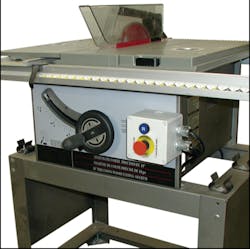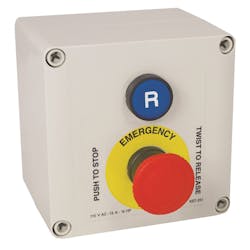Do Your Machines Have Anti-Restart Protection? Here's How to Find Out
The safety regulations that reference preventing accidental operation can be found in OSHA 1910.217 (b)(8)(ii) and ANSI B11.1-2009 (6)(2)(3). OSHA 1910 Subpart O specifies two categories of machines that require a motor starter with an anti-restart feature, also known as drop-out protection. These machines are mechanical power presses (OSHA 1910.217) and woodworking machines (OSHA 1910.213).
In their respective mechanical power press requirements, OSHA 1910.217 (b)(8)(iii) and ANSI B11.1-2009 (6)(2)(4) both state: "All power press controls shall incorporate a type of drive motor starter that will disconnect the drive motor from the power source in the event of control-voltage or power source failure. Operation of the motor-start button shall be required to restart the motor when voltage conditions are restored to normal."
OSHA 1910.213 (b)(3) for woodworking machines states: "On applications where injury to the operator might result if motors were to restart after power failures, provision shall be made to prevent machines from automatically restarting upon restoration of power."
NFPA 79-2007 "Electrical Standard for Industrial Machinery," which covers all industrial machines, states in 7.5.3 that "Upon restoration of the voltage or upon switching on the incoming supply, automatic or unintentional restarting of the machine shall be prevented when such a restart causes a hazardous condition."
To determine if your machine has drop-out (or anti-restart) protection, you can perform a function test by using the following steps:
- For purpose of this function test only, and with the motor running, turn off the power to the machine at the main power disconnect switch, or unplug it from the outlet. Do not use this method as an ongoing means of stopping your machinery, as it can be hard on the motor over time if repeated on an ongoing basis.
- Let the motor ramp down to a complete stop.
- Turn the power back on, or plug the machine back in.
- If the machine restarts, you do not have drop-out protection.
When a machine is running and then unexpectedly loses power, the main motor will stop after a certain rundown time. The related hazard is that an unexpected motor restart could directly initiate hazardous motion, and an injury could occur.
The most common method to prevent unexpected machine restart after a power failure, then power restoration, is a magnetic-type motor starter. Electrical contacts within the starter are magnetically separated upon loss of power. When power is restored, the main motor start button must be pushed to reconnect the electrical contacts and restart the machine.
Another more compact device designed for smaller machines is a drop-out device that is hard-wired to the machine.
For example, the Rockford Systems Sensing Saf-Start device features a reset button that must be pushed to restart the machine once power has been lost and then restored.
Several methods can be used to prevent unintended machine motor startup at the initial start, as well. It’s important to protect the main motor start button from accidental operation, such as accidentally bumping the start button. This can be accomplished by using:
- A ring guard around the start button
- A start button that is recessed or flush to the surface
- A fabricated shield over the start button.
It’s important to determine if your machinery has drop-out/anti-restart protection and to properly address your main motor starter if they don’t. Refer to OSHA, ANSI and NFPA 79 for all electrical requirements.
Rockford Systems offers a machine safeguarding seminar to teach people in positions of responsibility how to safeguard the point of operation and other machine hazards to meet these safety standards. This 2.5-day seminar explains how to interpret the performance language of both OSHA and ANSI B11-series safety standards.

